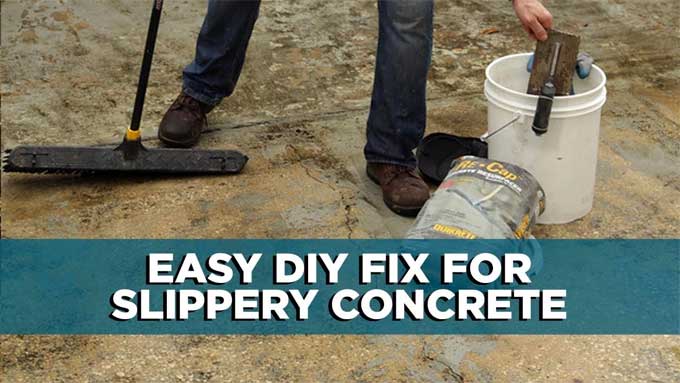
The Best Way to make Concrete Floors Slip-resistant in any Construction Building

An area adorned with concrete surfaces can complete the look of any room or setting. It is possible to consider concrete surfaces decorative if done correctly, adding to the aesthetic value of their surroundings. Nonetheless, you might have heard that accidents like slips and other mishaps occur more often than they should on concrete.
Winter makes concrete floors dangerously slippery, especially when wet or icy. Adding silica sand or additives to the sealer before it cures can make concrete non-slip. You can use non-slip strips or paint a slip-resistant layer on top of concrete that has already been sealed.
Key Methods of Making Concrete Slip Resistant
Anti Slip Sealer
Anti Slip Resistant Sealer is used for slip resistance for readymade concrete floor surfaces. Anti-slip sealers reduce slipperiness but change the surface's texture in the process. Sealants that penetrate below the surface work without altering the surface's texture.
In addition to reducing water absorption by 95%, water repellent sealers also make surfaces resistant to rain, snow, frost, etc. Besides protecting the surface from slippage, these sealers also protect it from wear and tear.
Non-Slip Additives
Adding non-slip additives will increase slip resistance if anti-slip sealers alone aren't enough. Depending on the level of traction required for a surface, non-slip additives are available in fine or coarse variations.
To increase the grip on the concrete surface, you can combine these sealers with grit additives. Typical grit additives include silica and plastic grit. Wet areas and heavily trafficked areas are coated with this coating.
The addition of aluminum oxide grit to sealers has proven hugely effective in concrete. Several types of sealants work well with aluminum oxide grit. Colors and performance are excellent without compromising appearance. Despite its low cost, this product can cover an area quite well.
Paint & Primer
Adding some grit additives to slippery concrete will make it non-slippery. The advantage of clear grit is that it does not make your concrete sealer look cloudy like silica sand. Likewise, you can purchase gritty material where you purchase concrete paint.
Add the paint according to the recommended proportions. In addition to sand and sawdust, the new material, sold specifically to make concrete less slippery is significantly lighter and easier to mix with the paint. As a result, you'll have no trouble using them.
Silica Sand
The surface can improve by applying silica sand to wet concrete sealers. After the first coat of fresh concrete sealer is applied, a silica sand layer is applied over it. After the silica sand layer dries, the second coat of concrete sealer is applied. When finished, the surface looks slightly cloudy or milky.
Non-Slip Strips
Stick-on non-slip strips can be found at hardware stores and are applied to outdoor concrete surfaces such as driveways, patios, steps, garages, etc. These strips prevent slippage by adhering to concrete surfaces and providing traction.
It is not the most aesthetic method, but concrete can make it less slippery with this method. You can paste stick-on, non-slip strips on your concrete surfaces at your local hardware store. Concrete surfaces indoors cannot treat with this method. That is also an excellent solution for concrete steps, garage floors, driveways, or any outdoor surface you want to make more secure.
Muriatic or Hydrochloric Acid
Slippery concrete can make rougher by etching it with a 25% muriatic acid solution. Concrete can become exposed to sand when acid eats away the surface. Concrete exposed to this kind of weather will have a surface that resembles sandpaper. Wet concrete becomes skid-resistant with this technique. Wear safety goggles, gloves, and protective clothing while performing that method.
To learn more, watch the following video tutorial.
Video Source: Today's Homeowner with Danny Lipford
Rock Salt
Rock salt applies to the concrete before it cures. You can smooth wet concrete with a trowel after sprinkling it with salt. Maintaining the attractive appearance of concrete surfaces involves removing the salt after curing.
You can also add water before curing concrete to reduce its slickness. Concrete can look more attractive with rock salt, because of its texture.
Wet concrete doesn't have to be slippery anymore - just sprinkle rock salt on it. Then use a trowel to smooth out the wet concrete. Salt on the concrete surface can remove after it has dried completely.
Wrapping it Up
Slippers can suffer serious injuries on slippery concrete floors. This issue is more likely to occur in floors that are color hardens, seals, or polishes. Irrespective of the size of the pool, untreated water can cause a lot of damage. Concrete can cause serious injuries to young people as well as older people.
Garage floors and steps near pools, especially when they are slippery, are usually accident-prone concrete surfaces. The above methods are simple, effective, and skid-safe over time. Talk to the manufacturer of the concrete sealer you use to make your surfaces non-slippery.


